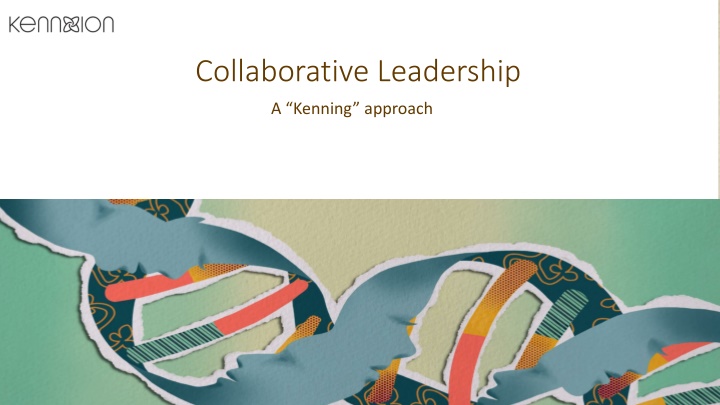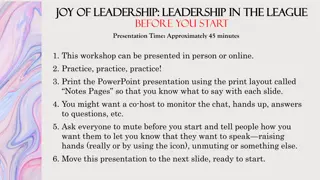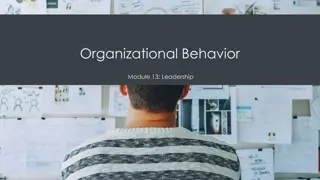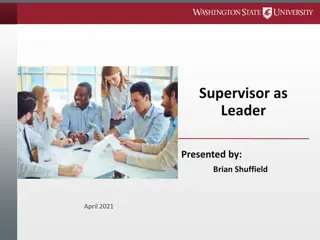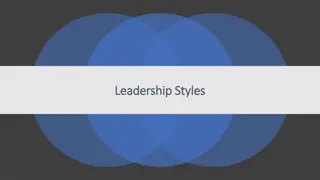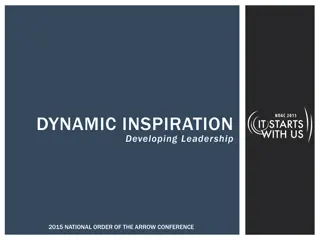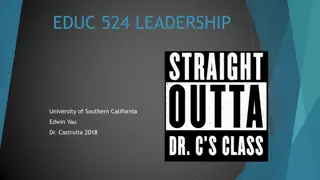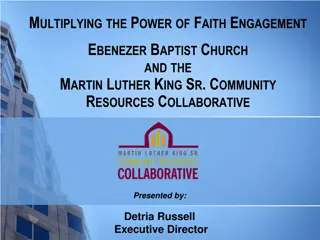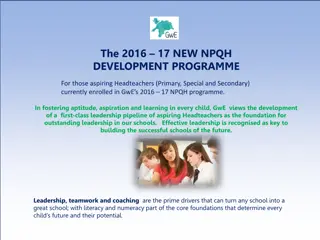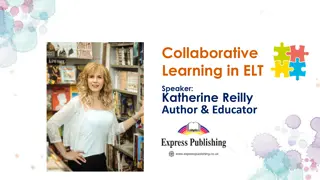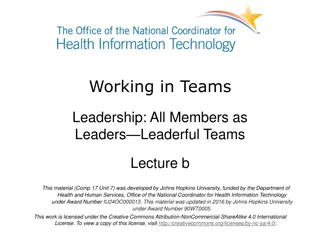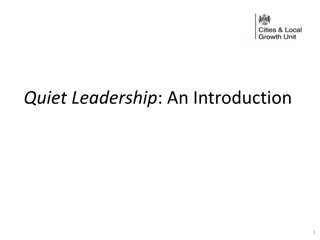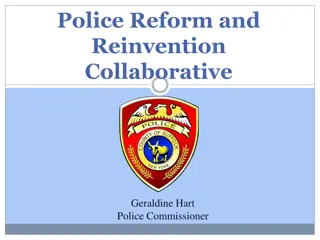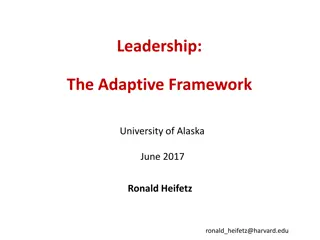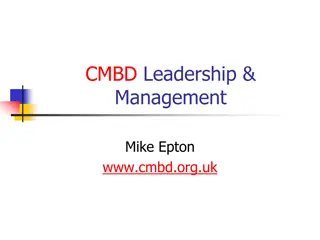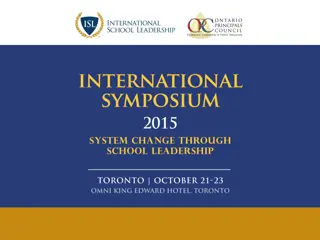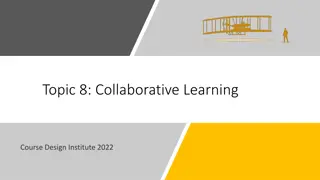Collaborative Leadership
Join the Collaborative Leadership program designed to enhance personal impact and foster collaborative work environments through a series of workshops, group sessions, and coaching. Learn the Kenning approach for problem-solving and engagement in Interpersonal Effectiveness, Engaging Complex Problems, and Personal Mastery disciplines. Discover powerful tools like Balcony Conversations to promote collaboration and sense-making among team members.
Download Presentation

Please find below an Image/Link to download the presentation.
The content on the website is provided AS IS for your information and personal use only. It may not be sold, licensed, or shared on other websites without obtaining consent from the author.If you encounter any issues during the download, it is possible that the publisher has removed the file from their server.
You are allowed to download the files provided on this website for personal or commercial use, subject to the condition that they are used lawfully. All files are the property of their respective owners.
The content on the website is provided AS IS for your information and personal use only. It may not be sold, licensed, or shared on other websites without obtaining consent from the author.
E N D
Presentation Transcript
Collaborative Leadership A Kenning approach
Todays Agenda Panel discussion Key concepts we will use throughout the program The 3 tools that will be the focus of individual modules Reflecting on your leadership challenges Time to play a game Program overview Next steps
Leadership Panel Tim Crowhurst Daryl Green Scott Pearson
What is the Collaborative Leadership program? A sequence of 4 video conference workshops, supported by small group work sessions and 1-1 coaching, customized to help participants increase their personal impact and work together collaboratively An investment we are making in you, recognizing the importance of what you do and your desire for professional growth An experiment to see if the tools and professional development techniques used by some of the world s preeminent learning organizations can support our drive for continuous improvement as we pursue our strategic goals A continuation of our learning and development partnership with Kenning Associates, extending work that CD leadership has benefited from over the past 4 years and adding new elements we believe will be helpful to key cross-functional team members
What does Collaborative Leadership mean? Being collaborative when you are the leader (i.e., have structural authority) Leading collaboration when you are responsible for getting others to work together but do not have structural authority We believe that sense making is the key to being collaborative yourself and facilitating collaboration among others
We will introduce the Kenning approach to engaging and solving problems and apply that approach to 3 disciplines that support collaboration Interpersonal Effectiveness Engaging Complex Problems Personal Mastery
You will learn how to use 3 powerful tools, one for each collaboration discipline Balcony conversations combine curiosity and transparency to treat people as sense-makers Interpersonal Effectiveness: We will introduce Balcony Conversations as a tool for structuring conversations, giving information, and listening that supports collaborative sense making and problem solving The Event Cartoon B A L C O N Y Data or Assumptions Sense made Sense made Personal Mastery: We will use the change immunities 4 Column Exercise to identify reactive tendencies that sometimes lead us to act in ways we know might not serve us so that we can understand the beliefs and assumptions that drive our behavior and make more intentional choices. Engaging Complex Problems: We will show how Polarity Mapping can identify problems that must be dynamically managed over time because they cannot be permanently solved and to create quantifiable guidepost to tell you when you should move in one direction or the other.
Taking a Kenning or sense-making approach to a problem requires looking for leverage and conducting iterative experiments Look beneath surface events (symptoms) to find root causes and conduct iterative, learning-oriented experiments to discovering emerging solutions See Own Events Trends and Patterns Structures Mental Models Act Design
Identifying root causes creates opportunities to increase leverage and achieve lasting results Opportunity for Action: React Events Anticipate and Adapt Trends and Patterns Increased leverage to achieve results Modify or Redesign Structures Examine, Transform Mental Models
The SODA cycle creates space for iterative improvements and personal development SEE Own What is your role in the problem. How do you participate? How do you benefit? How are you constrained? Get a vantage point as well as a point of view. What is the current state? What limitations/ problems are you running into? What actors and factors are in play and what are the dynamics? S O ACT DESIGN What are your options? Where can you get the most leverage? What hypotheses will you test and what data will you collect? A D Conduct your experiment, gather data, and repeat the cycle
Back to where we started: 1 approach, 3 disciplines Interpersonal Effectiveness Engaging Complex Problems Personal Mastery
The tools provide 3 different lenses through which to view, and manage, leadership challenges
https://kennxion.com/courses/collaborative-leadership-2023/ HQ is your one-stop source for all program materials Try pulling it up right now. 14
Now, click on the Kickoff link 15
Scroll to the bottom of the page, and you will find navigation links that help you move through HQ. You will also find one more bit of content. 16
The Game The Kicker You will be divided into 3 teams working in 3 different breakout rooms You will be given a story that includes a math problem You will have 15 minutes to submit your group s answer to the math problem The team that scores the most points wins You get points for getting the answer right in the shortest possible time Your team may have one or more Spies The Spies on your team win if your team submits an incorrect answer
How to neutralize a spy Anyone who thinks someone on their team is a spy can make an accusation at any time by saying I think NAME is a spy Once an accusation is made, the team must vote on whether the accused is or is not a spy. The accused does not have a vote If a majority vote that the accused is a spy, that person is removed from the team; they will stay in the breakout room but cannot say anything until the game is over If the vote is a tie or most vote that the person is not a spy, the accused remains on the team and the game continues There is no limit to the number of people who can be accused or the number of times an individual can be accused Spies are free to lie about being spies until the game is over
How to win Team Scoring Spy Scoring + 10 points for getting the right answer to the problem You win if your team gets the answer wrong + 2 points for every Spy correctly accused and removed + 1 point for every minute early you submit your answer, even if the answer is wrong. - 5 points for every Spy not removed - 2 points for every player removed who is not a Spy
What happens now Before we break you into teams, we will randomly assign some number of spies. We will do this by sending each of you an email. If the subject line of your message reads Spy, you are a spy. If the subject line says Team, you are not a spy. DO NOT SHOW YOUR MESSAGE TO ANYONE! Once everyone confirms they have seen their message, we will break you into 3 teams and send you into 3 breakout rooms. At that point, the 15-minute game clock will start You will find the story with the math problem as an attachment to your email message. The attachment will also include the rules and scoring pages A Kenning facilitator will join you in your room. The facilitator is neither a Spy nor a team member. We will just be observing Once your team has agreed on an answer and you are satisfied you do not want to make any more Spy accusations, announce that you are ready to submit your answer and give it to the facilitator. At that point, the game clock will stop and you will receive points for any extra time left Once the clock expires, the game ends and it is no longer possible to submit an answer or make accusations
2023 program in a nutshell All times EST T 5/9 8-9AM W 5/10 8-11AM Th5/11 8-9AM F 5/12 8-11 AM M 6/12 8-10 AM Th 6/15 8-10AM M 9/11 8-10 AM Th 9/14 8-10AM Th 4/25 8-10 AM M 10/16 8-10 AM Workshops Balcony Conversations Kickoff Immunities to Change Polarity Management Program Close 2 hours 8 hours over 4 days 4 hours over 2 days 4-8 hours self directed work 4 hours over 2 days 4-8 hours self directed work 2 hours Week of May 14 Week of June 18 Week of Sept 17 Balcony Conversation Applications Immunities to Change Applications Polarity Management Applications Pod Meetings 2 hours 2 hours 2 hours Week of May 28 Week of Oct 1 Week of May 7 Week of June 25 1:1 Coaching Goal setting Progress Review Progress Review Personal action plan 1 hour 1 hour 1 hour 1 hour 24
Meeting pre-work will focus on learning core concepts, with group time used for application Please plan for up to 2 hours of pre-work for each group session and ~1 hour reflection after each group session
Pods Pod 1: Shelley Pod 2: Mark Karla Karthik Michelle Andrea Patrick Jyothi Terra Rupak Greg Cinchu
What comes next Review the email from your coach, and sign up for your coaching sessions Login to HQ, and then... Prepare for your first coaching session Prepare for Workshop #1 (Balcony Conversations)
